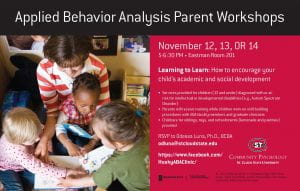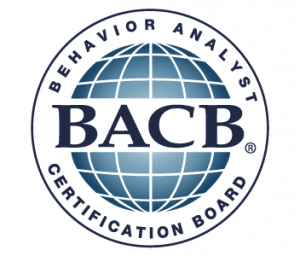
Photo by: Vanessa Bucceri
When a board certified behavior analyst (BCBA) first meets their client, they prioritize in building a positive relationship with the child. They want to know what their client likes and is motivated for. BCBAs are all about reinforcing good behavior. BCBAs often receive information from caregivers and people who have worked with children in the past on what they like. We know that preferences change frequently, so a BCBA will take time to systematically assess the child’s preferences after receiving recommendations from a parent.
The most common way a BCBA finds out what a child likes is through a preference assessment. Most preference assessments contain 5-10 items that may include toys, snacks, or activities. The first set of choices that are used are often picked based on information from caregivers and what is available to the BCBA at the time. Some common things that children work for are crackers, breaks (just having time to lay down or sit), electronic devices, toys, and time in the gym or on the playground.
The preference assessment included at the top of this post is called a Multiple Stimulus Without Replacement (MSWO). In this assessment the child is presented with multiple items (7 were used in the example) and they are asked to pick on item at a time, after they pick an item they get to spend time playing with it or eating it, and then that choice is no long available to them. This process repeats until the child has picked each of the items once, and the order in which they chose is recorded. Then the order in which the items are lined up is changed and the process starts over. At the end of the assessment items that a child chose first most often are identified at the high preference items.
Check out our Facebook page for a video demonstration!
Join us at our upcoming clinic sessions by RSVPing to Dr. Odessa Luna. Our upcoming Clinic topic is: Learning to Learn: How to encourage your child’s academic and social development. Dates will be November 12, 13, and 14 at 5:00 pm
.
Any other clinic sessions and updates will be posted on the clinic facebook, give it a like: https://www.facebook.com/HuskyABAClinic

Photo retrieved from BCBA.com
Within the field of applied behavior analysis (ABA), there are many titles a clinician can have. BCBA stands for Board Certified Behavior Analyst. Clinicians who hold this title have received a master’s degree, completed at least 1,500 hours of supervised work with implementation of behavior-analytic work, and taken an international certification exam. At the Husky ABA clinic, we have four faculty advisors who are BCBA-Ds, meaning that they have a doctorate degree in ABA or related behavior.
You may have noticed another title, the BCaBA, Board Certified assistant Behavior Analyst. BCaBA have undergraduate degree, completed at least 1, 000 hours of supervised works, and have passed an international certification exam. BCaBA’s
practice under the supervision of a BCBA, monitoring front-line clinicians that are implementing the individualized interventions the BCBA has created.
Finally, front-line clinicians in ABA, are often Registered Behavior Technicians (RBT). RBTs hands-on with the clients, directly implementing structured programming to help the child to be successful. RBTs work with clients every day to implement the interventions written by the BCBAs. RBTs are heavily supervised by both the BCaBA and BCBA to ensure treatments are implemented with fidelity.
Overall, in ABA, we aim to identify the changes we need to make in the environment to enhance the lives of clients AND the individuals around them like their parents, teachers, classmates, and siblings.
For more information about Applied Behavior Analysis check out https://www.bacb.com
Like us on FaceBook!
 Studies have shown that giving clients the opportunity to make choices in matters regarding their treatment can actually make treatment more effective! You might be asking yourself, “What does this look like outside of the clinic? How does choice align with me getting my child to do the things they need to do, but hate to do?” When a BCBA, like those found at our clinic, encourage caregivers to incorporate choice, we are not suggesting that the child gets to do anything and everything they want. Choice can be added naturally to your caregiving, without disrupting your ability to care for your child. You may find that adding choice may actually make it easier to get your child to do the things they don’t want to do, but are important…like tooth brushing!
Studies have shown that giving clients the opportunity to make choices in matters regarding their treatment can actually make treatment more effective! You might be asking yourself, “What does this look like outside of the clinic? How does choice align with me getting my child to do the things they need to do, but hate to do?” When a BCBA, like those found at our clinic, encourage caregivers to incorporate choice, we are not suggesting that the child gets to do anything and everything they want. Choice can be added naturally to your caregiving, without disrupting your ability to care for your child. You may find that adding choice may actually make it easier to get your child to do the things they don’t want to do, but are important…like tooth brushing!
Some children find toothbrushing to be a particularly aversive activity, but it’s important to their health and should be done. If your child hates brushing their teeth, choice can be incorporated to increase toothbrushing and/or decrease problem behavior during toothbrushing. One way to add choice to their tooth brushing time is to allow them to pick which toothbrush they would like to use each time they brush their teeth. Provide your child with two different toothbrushes that are theirs, and allow them to pick which one they would like to use each time they brush their teeth. As the caregiver, you probably know which toothbrush they will pick each time. However, still allowing the child to pick which brush they will use will give the child some autonomy and personal investment in the activity. If you can occupy the child with deciding on a toothbrush, you may find that they spend less time flat out refusing to do the activity. It’s also important to make sure there aren’t so many options that the client becomes overwhelmed. Choice could also be incorporated to this activity by allowing the child to pick between mint toothpaste, cinnamon, or bubblegum flavored toothpaste. If you are struggling to help the child brush for long enough, try asking the child, “Would you like to brush for two minutes or two-and-a-half minutes?” These are a few small steps that any caregiver can take to increase compliance for necessary tasks, without having to significantly disrupt your normal routine.
Another example of where choice can be used is with breaks. If you see that your child is getting upset and they need to take some time away from an activity, you should to give them a choice on whether or not they take a break. You can let them choose what they want to do during their break (draw vs nap), how long they want their break to be (three minutes vs five minutes), or where they take their break (at their desk vs on the floor). For example, you can ask them if they want to be away from their toys for four or five minutes. This will not only give them some control over their environment and themselves, but will also provide them with an opportunity to evaluate what they are feeling, how they are feeling, and what they need to feel better. Caretakers tend to be familiar with the cues that precede problem behavior, something that your child might not. Gently intervening when your child begins to exhibit signs of distress and offering them a choice about what you believe they might need to feel better is a great way to teach them to be aware of when they need to pay more attention to regulating their behaviors and how to do in a healthy way.
Our team is focused on providing assistance to caregivers and clients in a way that will foster independence, autonomy, and self-advocacy in clients. Providing small choices, throughout every day, is an excellent place to start teaching clients how to be more independent while continuing to pursue their therapeutic goals. Choice is not a cure-all and will not fix every problem behavior under the sun; however, choice is a powerful tool to foster independence in your loved one and help you and your child tackle those problem behaviors more effectively and efficiently.
Check SCSU’s program here!
Check out our Facebook page here!

Pictured are all of the first year students attending the on-campus program. Front row (L to R): Emilie Olson, Danielle Vesel, Karen Her, Zoe Cosato, and Naomi Ziegler. Back row (L to R): Averi Wright, Meghan Minor, Amanda Schoer, and Vanessa Hiley.
The St. Cloud State Applied Behavior Analysis Program is a two year program that prepares students to sit for the national Board Certified Behavior Analyst exam. During the first year of their program, students will spend a majority of their time in the classroom. Students will start by learning about the basics of behavior analysis and practicing some of these principles learned in a laboratory setting, while also receiving substantial training on the ABA code of ethics. These classroom and laboratory learning opportunities prepare the students for their practicum-heavy second year.

Pictured are a few of the “Second Years” that help with the ABA clinic. Front to back: Kelsey Loeffler, Kelly Berth, Sam Wanner, Chelsea Montag, and Josh Westphal.
Students in their second year will still take classes, but a majority of their time will be spent on site under the supervision of a currently licensed BCBA or similarly qualified professional. During this time, the second year students will either be preparing to take a comprehensive exam or working on their thesis under the supervision of a current faculty member. Students opting to go the thesis route will discuss methods of their study, procedures, practical and ethical dilemmas, etc. with the faculty member of their choice; the student usually chooses a professor who has a similar professional or research experience/interest. After a student has completed their second year in the SCSU ABA program, they will have passed all of the prescribed coursework, received their master’s degree in ABA, and completed 1,500+ hours of supervision by a licensed BCBA. Meeting all of these criteria allow the student to sit for the board certification exam and practice as a licensed BCBA upon passing. The SCSU ABA master’s program is one of the best in the country, boasting a 100% pass rate.
Check SCSU’s program here!
Check out our Facebook page here!
 Maybe you are interested learning more about what ABA, have attended the applied behavior analysis (ABA) workshops this month, or maybe you want to attend ABA workshops at the Husky ABA Clinic in the future (check out our Facebook).
Maybe you are interested learning more about what ABA, have attended the applied behavior analysis (ABA) workshops this month, or maybe you want to attend ABA workshops at the Husky ABA Clinic in the future (check out our Facebook).
ABA is the study of meaningful behavior change. In ABA, practitioners and clinicians, identify what causes behaviors (aggression, destruction, noncompliance) to happen and why they continue to occur and change over time. Behavior analysts focus on a client and what they’re doing; they also examine everything in the environment to create evidence-based interventions. For example, in a classroom, a behavior analyst may help a child struggling in school. She might look at how the child interacts with their peers, their teachers, and their family. She also may look at environmental factors like what tasks they like or do not like or even where they sit in class!
In ABA, there is a large focus on data collection. Behavior analysts want to document what changes are happening and be sure that any changes they put in place are helping their clients be successful. In ABA, we aim to keep our clients safe and independent. With the application of our science, we hope our clients can have the opportunity to access the things they need and enjoy, like a quality education, a job, and a social life. Not every child, can be the “the perfect kid,” and in ABA we recognize this. We want to help every child reach their full potential and set them up for success as they encounter new experiences.
At the Husky ABA Clinic, you can be confident that undergraduate, graduate, and faculty clinicians care for each family we serve. We all have experience working with children with a range of diagnoses and behavioral challenges. Additionally, faculty advisors are experts in the field, all Ph.Ds. Drs. Schulze, Witts, Traub, and Luna carefully supervise our graduate and undergraduate clinicians when they work with your child.
For more information about Applied Behavior Analysis check out https://www.bacb.com
Like us on FaceBook!
 Meet Josh, a second year student in the Applied Behavior Analysis (ABA) Master’s program at St. Cloud State. He graduated from Bemidji State University in 2014 with a Major in Psychology and minor in Sociology. After completing his degree at Bemidji State, Josh chose to get his master’s degree in ABA because of his interest in data driven practices. He decided to come to St. Cloud State because of the high pass rate for the board certification exam.
Meet Josh, a second year student in the Applied Behavior Analysis (ABA) Master’s program at St. Cloud State. He graduated from Bemidji State University in 2014 with a Major in Psychology and minor in Sociology. After completing his degree at Bemidji State, Josh chose to get his master’s degree in ABA because of his interest in data driven practices. He decided to come to St. Cloud State because of the high pass rate for the board certification exam.
Currently Josh works with individuals diagnosed with Intellectual and Developmental Disabilities (IDD) and co-occurring mental health conditions as a Behavior Analyst 3 with Community Support Services. Josh comes from an eclectic background, previously having worked in and managed in-home programs for adults and children with mental illness, children’s residential treatment, corporate foster care for adults and children, and individuals needing crisis placement for stabilization. Because of this varied background Josh has accumulated 15 years experience working with individuals carrying IDD or mental health diagnosis. In addition to these work experiences Josh also brings a wealth of knowledge from his six years in the Minnesota Army National Guard as a Combat Medic and his 2011-2012 deployment to Iraq and Kuwait in support of Operation New Dawn. While Josh has always applied some components pertinent to ABA in his work, his recent educational pursuits at SCSU have allowed him to take his ABA practices to a higher level.
Second year students have the choice do a thesis to graduate or take a comprehensive exam, and Josh chose to write a thesis. Josh’s thesis is twofold, one part is looking at how a Positive Behavioral Supports (PBS) model (typically used by schools) can be modified to incorporate the unique variables present in a group home facility. Secondly, using that modified model Josh plans to look at historical data set for clients within a group home facility to compare outcome measures before and after PBS interventions are introduced to the group home.
Even with all the time he spends working and studying, Josh has found time to raise two kids and two dogs. He takes the title of “dad” very seriously and is known for making painfully punny comments amongst many other “bad” jokes. If you’re interested in getting to know him and the other second year students check out the Facebook for more information on when our clinics will be happening here: https://www.facebook.com/HuskyABAClinic
 This is Emilie, another first year in St. Cloud’s Applied Behavior Analysis Masters program!
This is Emilie, another first year in St. Cloud’s Applied Behavior Analysis Masters program!
She graduated from Iowa State with a Bachelors degree in marketing and a Minor in Apparel Merchandising and Design. After spending some time working in Houston, TX as buyer at Gordmans, Emilie become interested in Applied Behavior Analysis and her ability to help others in socially significant ways through a career in ABA.
During her time in Houston, she worked on the side at behavior clinics. She started at University of Houston Clear Lake at their severe behavior disorders clinic where she helped with data collection and interventions. She then worked at Briar Cliff University as a therapist.
Emilie chose to come back to the Midwest for her Master’s because of the amazing faculty at St. Cloud State who are always excited to serve their students. The faculty also have a wide variety of experiences that Emilie is able to draw from to supplement her own experiences.
One thing Emilie is very proud of was her ability to leave her old life in her undergraduate major to pursue a more fulfilling career path. It’s not easy to go from a full-time job in marketing back to school in Applied Behavior Analysis, but Emilie is showing it’s never too late to change your mind and choose a new career.
A fun fact about Emilie is that her family came to the United States on the Mayflower. She is the 13th generation from the Mayflower and one of her family members was actually born on the boat during the journey to America.
To keep up to date with everything Emilie and other first year students are up to like us on facebook: https://www.facebook.com/HuskyABAClinic

Meet Danielle Vesel, she started graduate school in August 2019, making her one of our bright and shining “first years” in the SCSU Master of Science in Applied Behavior Analysis program!
Danielle holds a bachelor’s degree in psychology with an emphasis in Applied Behavior Analysis from University of Wisconsin – Eau Claire.
In her two years at UW – Eau Claire, she spent extensive time working with typically developing children and those diagnosed with ASD. These experiences were gained through an on-campus internship and through in-home work she did as a therapist. Danielle cites these experiences as what solidified her desire to work in the field of Applied Behavior Analysis and pursue the skills, training, and degree necessary to be a confident and qualified practitioner.
Since coming to SCSU in August, Danielle has become the president of the Student Organization of Behavior Analysis (SOBA). SOBA hosts monthly meetings that welcome undergraduate and graduate students interested in Behavior Analysis, providing them with engaging content about ABA, navigating an ABA education, and connecting interested students with career or internship opportunities related to ABA. Danielle has also attended the MNABA conference since coming to SCSU and making plans to attend the ABAI conference this spring!
Danielle’s goals in continuing her education involve refining and expanding her current skills to become a better leader and more critically thinking therapist.
Danielle is most proud of being involved in a degree dedicated to helping individuals be successful.
A fun fact about Danielle is: She likes to teach her cat, Remi, tricks AND is wonderful at it!
To keep up to date with Danielle and the clinic like us on facebook: https://www.facebook.com/HuskyABAClinic

Dr. Odessa Luna is an Assistant Professor in St. Cloud State University’s Master of Science in Applied Behavior Analysis program. Dr. Luna received her Ph.D. in Cognitive and Behavioral Sciences from Auburn University in 2019. Dr. Luna has been involved in the field of Applied Behavior Analysis for nine years.
Dr. Luna is most proud of the work she has done supervising and mentoring master’s students in behavior analysis. Her former trainees are disseminating evidence-based practices for individuals diagnosed with autism across the nation in clinics, schools, and residential centers.
Dr. Luna was originally drawn to the field of Applied Behavior Analysis by her in-home work as a therapist for a young child diagnosed with autism spectrum disorder who was nonverbal.
Dr. Luna’s intervention expertise/area of expertise is parent, staff, and teacher training.
Some fun facts about Dr. Luna are that she enjoys playing Pokémon Go and trying new ice cream flavors!
For frequent updates on Odessa and the clinic team like us on Facebook.











